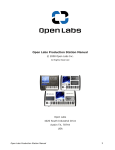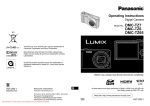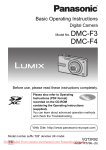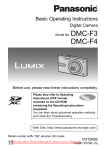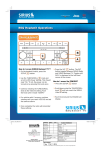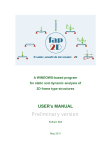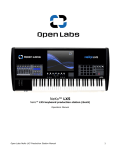Download User Manual - Truepianos
Transcript
TruePianos
User Manual
Version 1.9.0
© 2005-2011 4Front Technologies
All rights reserved
Manual version: v1.9.0 / 22.12.2010
Products of 3rd party companies are mentioned solely for information purposes.
Microsoft, Microsoft Windows © Microsoft Corporation
Mac, Mac OS X © Apple Inc.
CakeWalk Project 5 Version 2, SONAR, SONAR Producer, SONAR Home Studio XL © Twelve Tone Systems
Cubase, Cubase Studio, CuBase SL, Cubase SX, Steinberg, VST, ASIO © Steinberg Media Technologies GmbH
energyXT © Jørgen Aase
GarageBand © Apple Inc.
KarSyn © Open Labs
Logic © Apple Inc.
Pro Tools and RTAS are trademarks or registered trademarks of Avid Technology
All software and hardware terms not specified, as well as brand names, are registered trademarks or trademarks of their respective owners.
TruePianos User Manual
2
LICENSE AGREEMENT
1. This End-User License Agreement is a legal agreement between 4Front Technologies and the end-user
("Licensee") for the accompanied products ("Software") and the content material ("Content"), and it is covered by
the laws of the state California.
2. The Licensed Software is protected by copyright laws and international copyright treaties, as well as other
intellectual property laws and treaties. The Licensed Software is licensed, not sold.
3. The agreement unless entirely satisfactory is a subject for a negotiation and we are willing to provide the
reasonably altered agreement on request. Any alterations to the agreement should be explicitly approved by 4Front
Technologies.
4. However installing or otherwise using the Software indicates the approval of the present agreement.
5. This License Agreement also covers, unless stated otherwise, all the software and content updates and
supplemental materials, originating from the Software web site.
Software Updates and Technical Support
6. The Software updates and technical support are available free of charge for a defined term starting with the
purchase date. Technical support and the updates for the Software and the Content will only be provided for this
term, and after the period is due, the right to use the software will continue for the last version available during the
expiration date.
7. After the support and update term is due, it may be renewed manually at any time without a deadline. The exact
renewal term is seen at the time of payment at the order page.
8. The Customer is allowed to update early without losing the effective support term, as the renewal period shall
count only with the first download of the updated Software or Content, which was not available during the previous
support term.
9. Customers who chose not to renew, are still entitled to download and use the versions available during their
previous support terms.
Software
10. This agreement provides two possible licensing models of the software, which denote personal and collective
use. The License Model is defined at the time of purchase by the Licensee name, whether individual or a company
name. The license model can be adopted to the individual needs of a customer when standard models are
unfavorable. The standard implicit models are described below.
Personal Licensing Model
11. When TruePianos software is registered on a proper name, this gives the licensee the right to install TruePianos
on a reasonable number of personal computers, as long as licensee is the sole user of the software. In this case, the
agreement is relating to an individual. It is allowed for the other individual to use the software within the supervision
of licensee in the environment of Licensee, provided that it is used by only one person at a time.
TruePianos User Manual
3
Collective Use Licensing Model
12. To use this Licensing Model, the Software has to be registered on a company or a studio name. This allows the
Software to be installed only on one computer at a time, but does not limit the number of operators to work with the
software.
License Transfers and Licensing Model Changes
13. Each case of a License transfer or Licensing Model change is handled individually, and is granted only by the
written acknowledgement from 4Front Technologies. However, but not necessarily, 4Front Technologies retains the
right to deny the License transfer more frequently than every 6 months.
14. After the license is transferred, the prior owner of the license is obliged to uninstall the Software and the Content
and destroy all backup copies of it.
15. Upon the granted transfer, the user account will receive a new title and registration code.
Miscellaneous
16. The Licensee is welcome to use the software in a way to create musical scores, performances and tracks,
analyze and test the Software output, however is not allowed to disassemble or reverse engineer the Software or
the Content.
17. The Licensee may not re-sample the sounds or otherwise use the parts of the Software or the Content in a
competing product. However in a case of uncertainty, we would encourage Licensee to contact 4Front
Technologies.
18. The Licensee may not distribute the Software in whole or parts, or the software account information, unless
explicitly granted by a written permission from 4Front Technologies.
19. If reasonable evidence is found that the License Agreement is violated, 4Front Technologies reserves the right
to cancel the customer account, terminate the License Agreement and possibly take the reasonable legal steps.
Disclaimer
20. In no event shall 4Front Technologies and Third Parties involved in the development of this Software be liable
for any direct, indirect, incidental, special, exemplary, or consequential damages (including, but not limited to,
procurement of substitute goods or services; loss of use, data, or profits; or business interruption) however caused
and on any theory of liability, whether in contract, strict liability, or tort (including negligence or otherwise) arising in
any way out of the use of this Software or its Content, even if advised of the possibility of such damage.
TruePianos User Manual
4
NOTE
Please store your TruePianos reference code / password and the e-mail address used while purchasing the
product in a safe place.
TruePianos User Manual
5
TABLE OF CONTENTS
License Agreement .....................................................................................................................................................3
Note ............................................................................................................................................................................5
Introduction .................................................................................................................................................................7
System Requirements .............................................................................................................................................8
Subscription ............................................................................................................................................................9
Downloads ............................................................................................................................................................... 10
Staying up-to-date ................................................................................................................................................ 11
Product Activation .................................................................................................................................................... 12
Using TruePianos .................................................................................................................................................... 13
Initial Configuration (Options) .............................................................................................................................. 14
Keyboard Dynamics ......................................................................................................................................... 15
Increased Polyphony ........................................................................................................................................ 15
Multi-CPU Engine ............................................................................................................................................. 16
Sympathetic Resonance .................................................................................................................................. 16
Basic Interface ..................................................................................................................................................... 17
Advanced Interface .............................................................................................................................................. 18
Module selection............................................................................................................................................... 19
Preset Selection ............................................................................................................................................... 19
Reverb .............................................................................................................................................................. 19
Velocity Control Panel ...................................................................................................................................... 20
Tuning ............................................................................................................................................................... 20
Output Level ..................................................................................................................................................... 21
About .................................................................................................................................................................... 22
Supported MIDI Controls ......................................................................................................................................... 23
TruePianos User Manual
6
INTRODUCTION
Musicians becoming one with their instrument, telling lively and sometimes emotional stories through their music
can be a reality only when an instrument has the expressive and dynamic qualities, as well as the natural feel to
speak the artists' musical language.
TruePianos was developed with the ambition to produce the first virtual piano instrument which allows the user to
experience exactly this.
The product offers highly intuitive controls which allow you to painlessly adjust the instruments’ behavior to exactly
match the combination of your own unique playing style and the characteristics of your MIDI keyboard.
Following our tradition, TruePianos is optimized for real-time performance. The CPU usage is low even with 96 kHz
host sampling rates, and for advanced polyphony we support dual-core CPUs, spreading the load symmetrically.
TruePianos does not meticulously try to replicate existing pianos. Instead it uses a combination of the latest
sampler, physical modeling and synthesis techniques to produce our interpretation of great playable pianos.
With the release of TruePianos v1.0, the product reached a milestone where we felt it reached the point that was
needed to deliver, what it was originally intended to do.
Since the initial release several updates, which include several new modules have been released to our customers.
TruePianos still is under continuous development and we are dedicated keep evolving the product for quite some
time to come.
We hope, that one day in the near future we’ll be able to say that TruePianos is the piano plug-in of choice for many
musicians, no matter the preferred type of piano sound, no matter the musical style.
Gone are the days of the dinosaur sized piano libraries that you might have been used to. We welcome you to the
expressive world of TruePianos!
TruePianos User Manual
7
SYSTEM REQUIREMENTS
TruePianos system requirements vary, depending on the TruePianos module used. Future updates to the
TruePianos Core engine will most likely, also influence these requirements.
Because of this the system requirements below are estimations based on the current version of TruePianos.
Windows requirements
- Windows XP or newer
- 2.0 Ghz Pentium 4 or Athlon CPU
with SSE2 support
- 256 MB of free RAM
- A VSTi host (e.g. SONAR, Cubase, energyXT)
- A soundcard with proper ASIO drivers
Mac requirements
- Mac OS X 10.5 or newer
- Power PC G5* or any Intel based Mac
- 256 MB of free RAM
- AU/VST/RTAS host (e.g. GarageBand, Cubase, Pro Tools)
Meeting these minimum system requirements should allow you to use TruePianos with ‘normal polyphony’ and
‘sympathetic resonance’ activated. Enabling the Increased Polyphony option will most likely cause the sound to
break up and make TruePianos unsuitable for real-time performance.
Recommended Windows requirements
- 2.5-3 GHz Single-Core or 1.8 GHz Multi-Core
CPU or faster
- 512 MB of free RAM or more
Recommended Mac requirements
- Intel Multi-Core based Mac
- 512 MB of free RAM or more
Supported hardware VST players
- Muse Research Receptor models (OS 1.7 / 1.8)
- Muse Research Receptor 2 models (OS 1.8)
Meeting the recommended system requirements or having one of the supported hardware VST players allows you
to use the full capabilities of TruePianos.
* Modules released starting 2009 will require an Intel based Mac
TruePianos User Manual
8
SUBSCRIPTION
The full version of TruePianos includes a one year subscription to software updates and technical support.
Technical support and updates for the software and TruePiano modules will only be provided for the subscription
term. After the subscription is due, the right to use the software is restricted to the last available version at the
subscription expiration date.
After the support and update term is due, it may be renewed manually at any time without a deadline. The exact
renewal term is seen at the time of payment at the order page.
The Customer is allowed to update early without losing the effective support term, as the renewal period shall count
only with the first download of the updated Software or Content, which was not available during the previous support
term.
This subscription can be prolonged manually at any time without a deadline, as soon as the last period is over. The
exact renewal term is seen at the time of purchase or renewal at the order page.
Customers who chose not to prolong the subscription are still entitled to use the version available at the last day of
their prior subscription.
Details on how to prolong the subscription can be found in the Customers section of our website at
http://www.truepianos.com
TruePianos User Manual
9
DOWNLOADS
After buying TruePianos you will receive an email which informs you of your reference code. You’ll need this
reference code to download the full version and future updates, for activating the product and if this should one day
be required, to transfer your TruePianos license to another person.
To download the full version of TruePianos you’ll need to login to the special Customers section of our website.
Go to http://www.truepianos.com Customers Login using the e-mail address you used
while purchasing TruePianos as User Name and your reference code as Password
After logging in you can download the latest versions of TruePianos Core and all available piano modules.
TruePianos User Manual
10
STAYING UP-TO-DATE
You can expect to see regular updates for TruePianos on our website.
We are continuously doing research on how to further improve the heart of the product, the TruePianos Core, to
provide you with an even more immersive piano playing experience.
Released TruePiano modules may be improved and new piano modules will be in development, at least till well
into 2009.
If you wish to be informed whenever an update is released, feel free to subscribe to the TruePianos Newsletter.
To subscribe to the TruePianos Newsletter:
Go to http://www.truepianos.com go to the bottom of the page Subscribe Follow the
instructions given by the website.
TruePianos User Manual
11
PRODUCT ACTIVATION
Before TruePianos can be used it needs to be activated on any computer on which you install it. If TruePianos is
not yet activated, the TruePianos Activation dialog will pop up.
Windows
Mac OS X
Now enter your name and your reference code in the designated white input areas and click on OK.
If your reference code was entered correctly, the following dialog will appear.
Click OK to continue.
TruePianos is now activated and fully functional!
TruePianos User Manual
12
USING TRUEPIANOS
Great care was exercised to keep the user interface as intuitive as possible. As a result, the amount of controls is
kept at a minimum without sacrificing usability.
TruePianos produces a dry and unprocessed piano sound which won’t limit your creative freedom while
mastering/mixing your songs.
We believe that functionality offered by commonly available VST effects generally don’t belong in the user interface
of a virtual piano instrument. While we’ve made an exception for reverb which is very useful during live
performances in combination with the standalone version of TruePianos, implementations of additional mastering
effects would only complicate the user interface, without offering you the detailed controls and freedom offered by
the many excellent free and commercial VST effects out there.
Since TruePianos is optimized for CPU usage, it leaves most computers with more than enough headroom for
stacking VST effects on top of it, even during live performances where reliability of the instrument is crucial.
TruePianos User Manual
13
INITIAL CONFIGURATION (OPTIONS)
When using TruePianos for the first time, you’ll be shown the options screen, which allows to easily adjust and
store the most important settings.
To store your settings as the default settings click Save current plugin state as default. To close the options
screen click Close. To access this screen in the future, simply click on OPTIONS on the bottom bar of the User
Interface.
The settings on the options screen are explained in detail on the following two pages.
TruePianos User Manual
14
KEYBOARD DYNAMICS
The Keyboard dynamics slider is the most important control within TruePianos, as it is of great influence how
you’ll experience TruePianos.
This slider affects the velocity sensitivity curve, character of the instrument and many other aspects of the way
TruePiano modules will respond and sound. In non-technical language: It enables you to adjust TruePianos to the
combination of your playing style and the characteristics of your MIDI controller.
For my CME UF8 keyboard I find values -20...-17 to be close to optimal for my playing style. People with
full-weighted Yamaha keyboards will probably prefer the slider a value around zero.
Please, tune it to match your keyboard - just keep playing, and if it plays too difficult - move the slider to the left,
otherwise if the notes come too bright, move the slider to the right. When you are finished, click 'Save current
plugin state as default' and then 'Close'.
INCREASED POLYPHONY
Activating Increased Polyphony removes TruePianos’ default limit on the maximum amount of number of active
voices at a time (polyphony).
Be sure that your computer has at least a 1.5-2.0 GHz CPU if you plan to use this option during live performances.
Depending on your playing style, especially combined with heavy use of the sustain pedal, the amount of active
polyphony can easily surge far above 100 active voices. If your computer’s CPU is not powerful enough to handle
the increased polyphony in real-time, disable this option, especially when reliability is crucial.
On slower computers, Increased Polyphony can still be enabled to render your final composition. When doing so,
always realize that a musician, while playing an instrument, will adjust to how the instrument itself behaves. If you
play a piece of music at ‘normal polyphony’ and render the final result with ‘increased polyphony’, some of this
musician-instrument interaction will be missing.
TruePianos User Manual
15
MULTI-CPU ENGINE
If you have a computer with two CPUs, or a dual-core CPU, TruePianos can take full advantage of the additional
processing power offered by such a system. By enabling the Multi-CPU Engine the CPU load will be equally spread
among both CPUs/Cores.
This is particularly useful while using the Increased Polyphony mode if your playing style combined with your
sustain pedal usage is very polyphony hungry.
If you don’t know whether your CPU has multiple cores you might try if enabling the Multi-CPU engine improves
TruePianos’ performance on your system.
Note, that some applications (such as Cakewalk SONAR for Windows) have their own way of handling multi-core
processors, which depending on your setup, may not work very well together with TruePianos’ Multi-CPU support
turned on.
Since nobody has yet defined a standard of how the processor CPU time should be managed on multi-core
workstations, we invite you to check these options and find the best balance of quality versus performance on your
system.
Examples of multi-core CPUs which are able to take full advantage of the Multi-CPU engine are
the Intel Core Duo, Intel Core 2 Duo, the Pentium 4 D(ual) and the Athlon X2.
SYMPATHETIC RESONANCE
When playing a real piano, hammers cause strings to vibrate which results in musical notes. This vibration of strings
can cause other strings that are not damped to vibrate.
Enabling Sympathetic Resonance currently simulates the described behavior while the sustain pedal is down on
all notes that are still playing.
Normally Sympathetic Resonance should be activated. In some cases you might want to disable it when you need
the pedaled sound to be sharp and free of additional ambience.
The impact of Sympathetic Resonance on TruePianos’ CPU usage is negligible, even on slow
computers.
TruePianos User Manual
16
BASIC INTERFACE
TruePianos has two main user interfaces. One is the Basic Interface. This interface offers only the ‘basic’ controls
required for playing the piano after being configured using the Options screen.
1
4
2
3
5
6
INTERFACE USAGE
1. Piano Keys
- Click: quickly audit the sound of a module/preset.
- Shows the keys that are currently being played on the MIDI keyboard.
2. Module/Preset name
- Shows the currently active module and preset.
- Click: Select the desired module or preset by name.
3. Up/Down arrow
- Click: Selects the next/previous module or preset.
4. Advanced Interface
- Click: Switches to the advanced user interface.
5. Options
- Click: Displays the ‘options’ menu.
6. About
- Click: Displays the ‘about’ menu.
TruePianos User Manual
17
ADVANCED INTERFACE
If you want full control with instant access to all available settings within TruePianos and don’t care about seeing an
onscreen keyboard the Advanced Interface is for you.
B
A
1
2
3
INTERFACE USAGE
1. Basic Interface
- Click: Switches to the basic user interface.
2. Options
- Click: Displays the ‘options’ menu.
3. About
- Click: Displays the ‘about’ menu.
A. Value boxes
- Click: Allows typing a precise value.
- Enter: Confirm entered value.
B. Sliders
- Click and hold while moving the mouse: Moves the slider to another position.
- Click and hold while moving the mouse: Overrides active ‘value box’ input.
- Click+Shift and hold while moving the mouse: Moves the slider to another position at greater precision.
- Double-Click: Reset slider to default value.
TruePianos User Manual
18
MODULE SELECTION
The active module name is highlighted while its icon is slightly dimmed. To load a different module, click on the icon
of the preferred module.
If more modules are available than fit in the panel, arrows will appear on the sides
of the panel. You can click on these arrows to scroll through the available
modules.
PRESET SELECTION
This panel shows a list of available presets within the active
piano module, as well as a short description of the active
module. The currently active preset is highlighted.
To select a preset, click on its name.
REVERB
This panel offers the option to add reverb to the normally dry sound TruePianos
produces. This is particularly useful if you plan to use TruePianos during live
performances using the standalone version of the product. Reverb can be controlled
using two sliders:
Amount: This slider determines how loud the wet reverb sound should be compared
to the normal dry output sound. Moving the slider to the right increases the amount of
reverb that’s applied while moving it to the left reduces the amount. Moving the slider completely to the left switches
it off.
Room Size: By moving this slider you determine the size of the room that’s simulated. Moving it to the right to
increases the simulated space, while moving it to the left reduces it.
TruePianos User Manual
19
VELOCITY CONTROL PANEL
The velocity control panel offers a collection of controls which allows you to adjust how TruePianos behaves to MIDI
input.
The Velocity control graph is affected by three sliders: The Velocity Floor, Velocity Threshold and Keyboard
Dynamics slider.
Velocity Floor: This slider allows you to bring out the less bright piano sound of
playing a piano softly, at much higher velocity levels as normally would be the
case. It can be used to make presets darker as well as to compensate for
not-so-perfect MIDI keyboards that don’t let you play well at lower velocities.
Don’t set the position of this slider too high. Doing so can make a piano module
sound less expressive or even synthesized!
Velocity Threshold: Sets the minimal MIDI input velocity value TruePianos reacts
to. This option is meant for people with sensitive non- and semi-weighted
keyboards. Moving this slider a bit to the right avoids that you accidentally play a
note while resting your hands on the MIDI keyboard.
Keyboard Dynamics: This slider affects the velocity sensitivity
curve, character and many other aspects of the way TruePiano
modules will respond and sound. See page 19 for a full
description.
Release: Changes the duration of a note going silent after a key
on the MIDI keyboard is released while the sustain pedal is up. A
negative value shortens the release time while a positive value
higher than 0 increases it.
TUNING
The A4 pitch panel allows you to tune TruePianos based on the frequency of the A4 note. By default
most software based instruments have their tuning based on A4 being at 440.0 Hz.
This is especially useful for combining TruePianos with acoustic or software instruments that are not
tuned to 440.0 Hz.
The left slider changes the tuning frequency in 1 Hz steps, while the right slider works in 0.01 Hz
steps (cents).
TruePianos User Manual
20
OUTPUT LEVEL
The Output Level displays output levels graphically for both the left and right channel individually
and allows you to lower the output level of TruePiano modules.
Moving the slider downwards from its default top position will reduce the sound output level by the
amount of dB displayed in the value box.
TruePianos User Manual
21
ABOUT
The About screen displays the licensee name and provides buttons that bring you directly to a page on the
TruePianos website (Internet Connection required).
5
1
2
3
4
INTERFACE USAGE
1. Website
- Click: Shows the front page of the TruePianos website (http://www.truepianos.com).
2. Demos
- Click: Let’s you listen to music other people have made using TruePianos.
3. Quick Tour
- Click: Shows a quick overview of the product.
4. Update
-Click: Brings you directly to the update page where you need to login using your e-mail address as User
Name and your reference code as Password
5. Close About screen
-Click on any location within the TruePianos interface where there is no button.
TruePianos User Manual
22
SUPPORTED MIDI CONTROLS
Patch Change
Control 000
Control 007
Control 022
Control 023
Control 024
Control 025
Control 026
Control 027
Control 028
Control 064
Control 066
Control 067
Control 072
Control 091
Control 127
Change Preset
Select Module
Volume
Velocity Threshold
Velocity Floor
Tuning (Hertz)
Tuning (Cents)
Keyboard Dynamics
Room Size
Reverb Amount
Sustain Pedal
Sostenuto Pedal
Soft Pedal
Release
Reverb Amount
Reset Engine (all notes off)
TruePianos User Manual
23
TruePianos User Manual
24

























